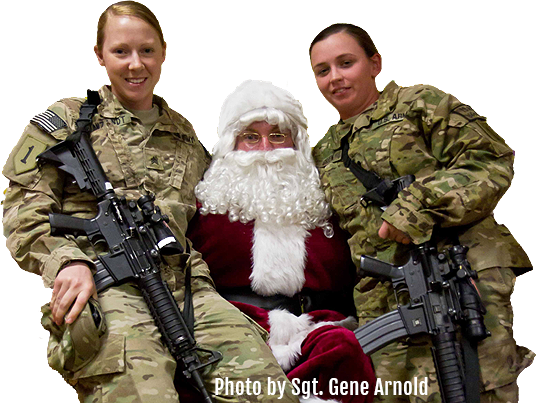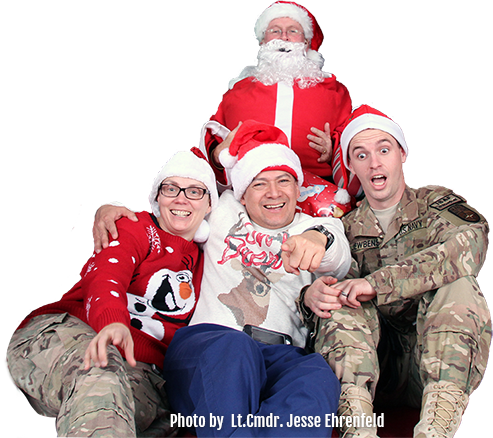Meet Your Military
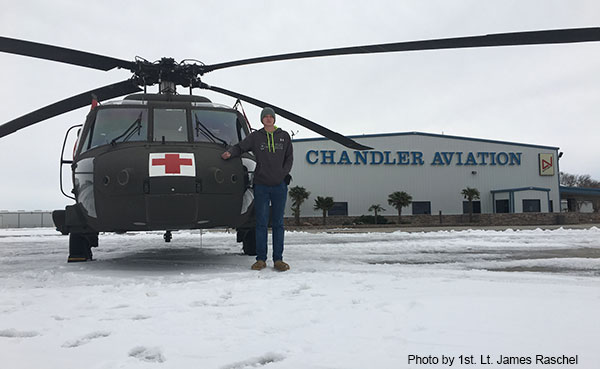
- Details
- Hits: 3883
ARLSBAD, N.M., January 4, 2016 — While many of his fellow National Guard soldiers were called to state active duty in response to recent blizzards here, Army Pfc. David Mathews went to work in his civilian job on his own time — refueling the medical evacuation helicopters called in to help.
The New Mexico National Guard was activated when a winter storm hit the southeastern section of the state Dec. 26. Soldiers have since been busy finding and helping stranded motorists, providing transportation to and from medical care, and assisting state authorities with clearing roadways.
Read more: Meet Your Military: Citizen-Soldier Supports Guard in Civilian Capacity
- Details
- Hits: 3804
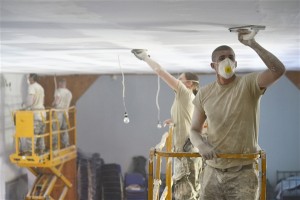 Army Spc. Christopher Anderson, a carpentry and masonry specialist, smooths plaster on a ceiling while working with fellow Minnesota Army National Guardsmen and Croatian soldiers to repair and rebuild a roof on a damaged community center in Racinovci, Croatia, June 18, 2015. Anderson is assigned to the 851st Vertical Engineer Company. Minnesota National Guard photo by Air Force Tech Sgt. Lynette OlivaresRACINOVCI, Croatia, July 27, 2015 – The Minnesota National Guard's State Partnership Program with Croatia has been going on for decades. In conjunction with U.S. European Command, Minnesota units or teams take on logistics and labor-intensive projects in a village in Croatia.
Army Spc. Christopher Anderson, a carpentry and masonry specialist, smooths plaster on a ceiling while working with fellow Minnesota Army National Guardsmen and Croatian soldiers to repair and rebuild a roof on a damaged community center in Racinovci, Croatia, June 18, 2015. Anderson is assigned to the 851st Vertical Engineer Company. Minnesota National Guard photo by Air Force Tech Sgt. Lynette OlivaresRACINOVCI, Croatia, July 27, 2015 – The Minnesota National Guard's State Partnership Program with Croatia has been going on for decades. In conjunction with U.S. European Command, Minnesota units or teams take on logistics and labor-intensive projects in a village in Croatia.
The experience of helping a community in need isn't new for most Minnesota Guard members, including Army Spc. Christopher Anderson, a carpentry and masonry specialist from the 851st Vertical Engineer Company out of the Camp Ripley Training Center.This year marks his second trip to Croatia. This year's trip includes a team of about 30 Minnesota Guardsmen who have less than three weeks to repair the large roof of a village community center badly damaged by flooding last year. "Being able to come and do missions like this is awesome," Anderson said."Trips like this make your time in the Guard a lot more enjoyable, and it's nice to change things up."
'A Big Satisfaction' The project in the local community has attracted onlookers from around the village. Many are interested in the progress and the American military unit which has joined them temporarily in their villages and places they call home. "It's a big satisfaction to build something, see people enjoy it and how it affects the community," Anderson said.
Read more: Meet Your Military: Minnesota Guardsman Helps Croatian Village
- Details
- Hits: 5332
 Air Force Tech. Sgt. Bethany Watson, noncommissioned officer in charge of the 18th Wing First Term Airman Center, sits on her lead stationary bicycle July 13, 2015, in the Risner Fitness Center at Kadena Air Base, Japan. U.S. Air Force photo by Airman 1st Class Lynette RolenKADENA AIR BASE, Japan: With her energetic voice, Air Force Tech. Sgt. Bethany A. Watson commands the room full of cyclists from her lead stationary bicycle as they pedal vigorously in the dimly lit, music-filled exercise room at Risner Fitness Center here.
Air Force Tech. Sgt. Bethany Watson, noncommissioned officer in charge of the 18th Wing First Term Airman Center, sits on her lead stationary bicycle July 13, 2015, in the Risner Fitness Center at Kadena Air Base, Japan. U.S. Air Force photo by Airman 1st Class Lynette RolenKADENA AIR BASE, Japan: With her energetic voice, Air Force Tech. Sgt. Bethany A. Watson commands the room full of cyclists from her lead stationary bicycle as they pedal vigorously in the dimly lit, music-filled exercise room at Risner Fitness Center here.
As she guides the rapidly exhausting class members through the rigorous spin workout, it becomes more and more evident: leading is in her blood. Watson is the noncommissioned officer in charge at Kadena’s First Term Airman Center, and she’s one of the first leaders new airmen meet when they arrive here for their first duty assignment. "The whole reason I came to FTAC in the first place is because I had a rough time as an airman," she said. "I wasn't focused. I didn't know what I was doing and many other things. I was just floundering. That's really why I wanted to come and do this job specifically. I just really have a heart for the airmen -- to get them started out on the right path. "
Read more: Meet Your Military: Military Leader by Day, Spin Instructor by Night
- Details
- Hits: 10293
 New York Army National Guard Capt. Jeremy Hillyard pushes upward during a powerlifting competition in Rochester, N.Y., August 8, 2015. Hillyard, who began weightlifting while stationed at Guantanamo Bay in 2011-2012, successfully defended his weightlifting records set in previous competitions.WEBSTER, New York– What started as a weightlifting hobby at the gym while deployed at Guantanamo Bay in 2011 and 2012 has become a record-breaking event for New York Army National Guard Capt. Jeremy Hillyard.
New York Army National Guard Capt. Jeremy Hillyard pushes upward during a powerlifting competition in Rochester, N.Y., August 8, 2015. Hillyard, who began weightlifting while stationed at Guantanamo Bay in 2011-2012, successfully defended his weightlifting records set in previous competitions.WEBSTER, New York– What started as a weightlifting hobby at the gym while deployed at Guantanamo Bay in 2011 and 2012 has become a record-breaking event for New York Army National Guard Capt. Jeremy Hillyard.
Hillyard, a battle-staff officer in the 27th Infantry Brigade Combat Team headquarters based in Syracuse, took five prizes in the Aug. 8-9 Revolution Powerlifting competition in Rochester. More than 300 weightlifters took part in the regional competition, one of the largest on the East Coast. “Nothing compares to the adrenaline when you are competing against yourself; it takes mental and physical strength when you are no longer in front of just a mirror but instead hundreds of people,” Hillyard said. “Getting your body to do something you may not have been able to do a month ago is something special.”
Hillyard discovered weightlifting when he was serving as part of Joint Task Force Guantanamo with the New York Army National Guard’s 107th Military Police Company. He looked for something to fill time in a productive and positive manner and followed the path of fellow soldiers to the base gym. Hillyard said he excelled at lifting weights but he stopped lifting weights when he redeployed here from Cuba.
Read more: Meet Your Military: New York Guard Officer Becomes Champion Powerlifter
- Details
- Hits: 6885
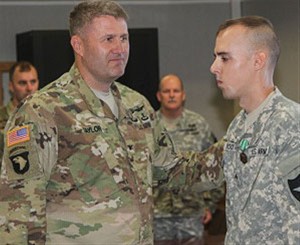 Army Col. William Taylor, commander of the 2nd Combat Aviation Brigade, left, presents the Army Commendation Medal to Army Cpl. Tristan L. Booth, a native of Maple Valley, Wash., and the senior cable system installer/maintainer from Headquarters and Headquarters Company, 2nd CAB, during a ceremony on Camp Humphreys, South Korea, Aug. 5, 2015. Booth was recognized for his efforts in saving a Korean civilian's life. Courtesy photoCAMP HUMPHREYS, South Korea, Aug. 12, 2015 – Army Cpl. Tristan L. Booth helped to rescue an injured South Korean citizen who’d fallen onto the railroad tracks at a train station in the nearby city of Pyeongtaek.
Army Col. William Taylor, commander of the 2nd Combat Aviation Brigade, left, presents the Army Commendation Medal to Army Cpl. Tristan L. Booth, a native of Maple Valley, Wash., and the senior cable system installer/maintainer from Headquarters and Headquarters Company, 2nd CAB, during a ceremony on Camp Humphreys, South Korea, Aug. 5, 2015. Booth was recognized for his efforts in saving a Korean civilian's life. Courtesy photoCAMP HUMPHREYS, South Korea, Aug. 12, 2015 – Army Cpl. Tristan L. Booth helped to rescue an injured South Korean citizen who’d fallen onto the railroad tracks at a train station in the nearby city of Pyeongtaek.
Booth, a native of Maple Valley, Washington, and the senior cable system installer/maintainer from Headquarters and Headquarters Company, 2nd Combat Aviation Brigade, was at the AK Plaza with his then-fiancé, Juran Hyun, during the May 3 incident. The weekend was coming to a close, with Booth saying goodbye to Hyun as she headed back to Seoul on the subway.
The couple was sitting on a bench when Booth overheard a Korean civilian making strange noises. Then, Booth heard a loud bang, “and saw everyone moving to the edge of the platform and looking down toward the tracks.” He added, “Once we got to the crowd, I could see a man lying face up on top of the track.”
Providing Assistance Booth jumped down along with a civilian to try and help the man who had fallen.It took them two or three attempts to lift the heavy man to the top of the platform before they could get themselves out of harm’s way. “I didn’t know if a train was going to come or not,” Booth said. “I am still in shock that I jumped down there.” Once they were safe on top of the platform, Booth noticed a severe laceration on the man’s head. Booth remembered he had a t-shirt inside of his backpack and rushed to retrieve it.
Read more: Meet Your Military: U.S. Soldier Aids Injured South Korean Civilian




